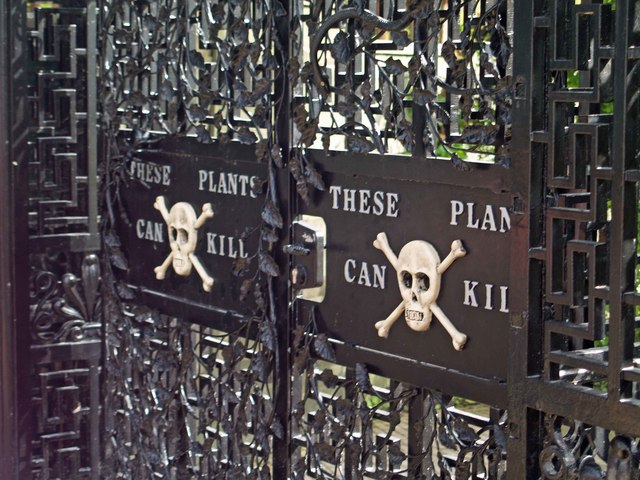Do Not Touch, Eat, or Even Smell The Flowers
In life, we’re told to “stop and smell the roses.” The adage doesn’t apply to real flowers — it’s a reminder that, in the hustle and bustle of our day-to-day, we should take a moment and appreciate the world around us and the little things we take for granted. And it’s generally good advice, especially if there are actually some roses around. Why not? Roses smell nice, and it’s good to enjoy nature. So yeah, stop and smell the roses.
Unless you’re at Alnwick Castle in Northumberland, England. (Here’s a map.) In that case, it still may be okay to smell the roses — just make sure you’re not in the part of the grounds with the dangerous stuff. How will you know? Here’s a clue:
Those are the gates to the aptly named Poison Garden within Alnwick’s confines. Per the garden’s website, the garden is “filled exclusively with around 100 toxic, intoxicating, and narcotic plants. The boundaries of the Poison Garden are kept behind black iron gates, only open on guided tours. Visitors are strictly prohibited from smelling, touching, or tasting any plants.” There are plenty of tours — every 30 minutes while the garden is open to the public — and to date, no one has died while traversing its grounds, despite the ominous warning on the gates.
But that’s not because the warning is wrong. There are a lot of trees and plants there that can cause people (and, apparently, dogs) a lot of harm. Dean Smith, a guide at the Poison Garden, told the BBC that “Probably the most poisonous plant we actually have here is ricin [which contains the toxin ricin] better known as the castor bean or castor oil plant. The Guinness Book of World Records considers that to be the world’s most poisonous plant.” And then, there’s the laburnum tree, the second-most poisonous tree native to the UK after the yew (which explains why Voldemort’s wand is made from a yew branch, now that I think about it). Per Smith, “The tree is so poisonous that if one of the branches was to fall to the floor, lay there for several months and the dog later comes along, picks it up to hold as a stick on a walk, chances are the dog won’t finish the walk. It’s that poisonous.
The danger is by design. As Smithsonian Magazine explains, in 1995, Jane Percy (née Richard) became the Duchess of Northumberland when her husband’s brother died of a drug overdose. The Duke and Duchess of Northumberland also get title to Alnwick Castle, and “Percy’s husband asked her to do something with the gardens, which at the time were a disused commercial forestry boasting nothing more than rows and rows of Christmas trees.” And she wanted to make that project one good enough to attract visitors, so, as she told Smithsonian, “If you’re building something, especially a visitor attraction, it needs to be something really unique. One of the things I hate in this day and age is the standardization of everything. I thought, ‘Let’s try and do something really different.” So she began collecting plants that can kill you — and then invited people to visit (but not die).
The garden opened a decade later and has been a hit since. Most plants are there, out in the open, tempting visitors to touch (but again, please don’t). Some, though, are locked in glass cases or otherwise behind lock and key. One is the gympie-gympie, also known as the stinging bush, which per Wikipedia’s editors “is notorious for its extremely painful and long-lasting sting” — the Poison Garden doesn’t want people accidentally brushing against it and howling in pain. But most other, per Smithsonian, are “a variety of drugs, from cannabis to cocaine (derived from the leaves of the coca plant), which [the duchess] and garden guides use as a jumping-off point for drug education.” Those are locked away to prevent people from stealing them, and — just in case — the garden guides keep a strict count on the number of each of those plants before and after every tour.
Bonus fact: Bill Nye, better known as Bill Nye the Science Guy, really appreciated his garden — and his kind-of ex-wife didn’t. In early 2006, Nye married musician Blair Tindall but, a few weeks later, the couple discovered that the marriage license wasn’t properly executed. Legally speaking, the couple was never actually married, and the pair decided to get their relationship annulled. But the breakup turned less than amicable. As CBS reported, “Nye says his distraught ex-wife-that-never-was poured a toxic liquid into the garden behind the house they both owned, a substance Tindall later said was weed killer. Nye took out a restraining order against her.” The two did not reconcile.
From the Archives: David’s Garden: You can’t touch the plants in this garden, either, because the whole garden is sealed.

